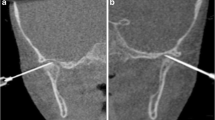Abstract
Background
Manufacturers have provided C-arm CT imaging technologies for applications in interventional radiology in recent years. However, clinical imaging protocols and radiation doses have not been well studied or reported.
Objective
The purpose of this study is to develop low-dose settings for clinically acceptable CT imaging of temporomandibular joint in interventional radiology suites, using a C-arm imaging angiography system.
Materials and methods
CT scans were performed with a flat-panel digital C-arm angiographic system on a 5-year-old anthropomorphic phantom. The CTDI was determined for various rotation times, dose settings and Cu filter selections. The CTDI values were compared with those of conventional low-dose CT for the same phantom. The effectiveness of using Cu filters to reduce dose was also investigated. Images were reviewed by a senior radiologist for clinical acceptance.
Results
The manufacturer’s default setting gave an equivalent CTDI of 4.8 mGy. Optimizing the dose settings and adding copper filtration reduced the radiation dose by 94%. This represents a 50% reduction from conventional CT.
Conclusion
Use of Cu filters and low-dose settings significantly reduced radiation dose from that of standard settings. This phantom study process successfully guided the clinical implementation of low-dose studies for all ages at our institution.










Similar content being viewed by others
References
Racadio JM, Drazenko B, Homann R et al (2007) Live 3D guidance in the interventional radiology suite. AJR 189:W357–W364
Racadio JM, Bradley LF, Jones BV et al (2006) Three-dimensional rotational angiography of neurovascular lesions in pediatric patients. AJR 186:75–84
Soulez G, Dubois J, Giroux MF et al (2006) Value of angiographic computed tomography (Dyna-CT) in the treatment of vascular anomalies. Education exhibit (poster). RSNA 92th Scientific Assembly and Annual Meeting, Chicago, IL, USA
Smyth JM, Sutton DG, Houston JG et al (2006) Evaluation of quality of CT-like images obtained using a commercial flat panel detector system. Biomed Imaging Interv J 2:e48
Fahrig R, Dixon R, Payne T et al (2006) Dose and image quality for a cone-beam c-arm CT system. Med Phys 33:4541–4550
Cahill AM, Baskin KM, Kaye RD (2007) CT-guided percutaneous steroid injection for management of inflammatory arthropathy of the temporomandibular joint in children. AJR 188:182–186
Author information
Authors and Affiliations
Corresponding author
Rights and permissions
About this article
Cite this article
Zhu, X., Felice, M., Johnson, L. et al. Developing low-dose C-arm CT imaging for temporomandibular joint (TMJ) disorder in interventional radiology. Pediatr Radiol 41, 476–482 (2011). https://doi.org/10.1007/s00247-010-1885-2
Received:
Revised:
Accepted:
Published:
Issue Date:
DOI: https://doi.org/10.1007/s00247-010-1885-2




